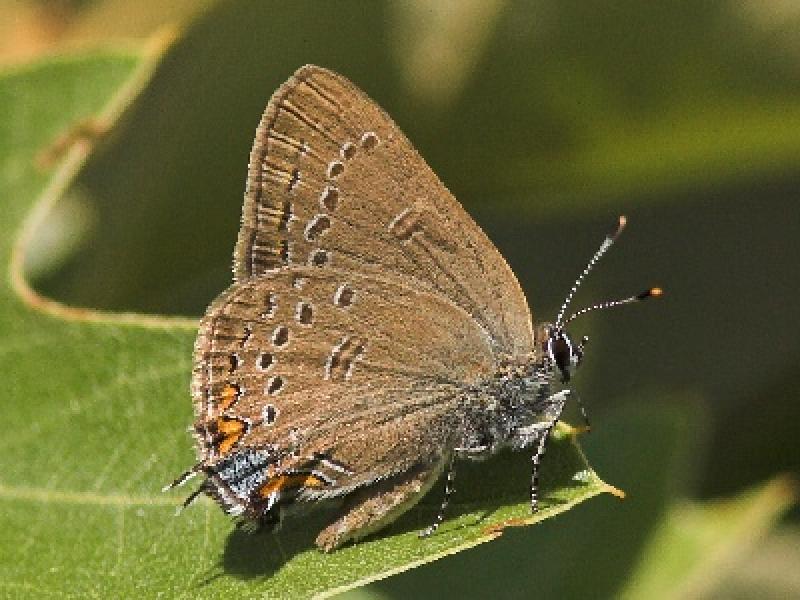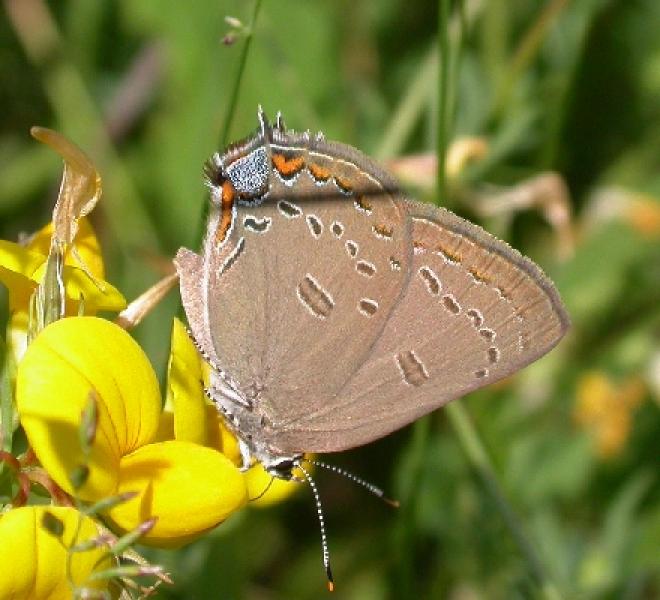Edwards' Hairstreak
Satyrium edwardsii (Grote and Robinson, 1867)
- Class
- Insecta (Insects)
- Family
- Lycaenidae (Blues, Coppers, Hairstreaks, Elfins)
- State Protection
- Not Listed
Not listed or protected by New York State.
- Federal Protection
- Not Listed
- State Conservation Status Rank
- S3S4
Vulnerable in New York, or Apparently Secure - Vulnerable to disappearing from New York (but not currently imperiled), with relatively few populations or locations, few individuals, and/or restricted range; or uncommon but not rare in New York; may be rare in some parts of the state; possibly some cause for long-term concern due to declines or other factors. More information is needed to assign either S3 or S4.
- Global Conservation Status Rank
- G4
Apparently Secure globally - Uncommon in the world but not rare; usually widespread, but may be rare in some parts of its range; possibly some cause for long-term concern due to declines or other factors.
Summary
Did you know?
The larvae of Edwards' Haristreak and some related butterflies are defended by ants who eat sweet secretions from them. The ants that tend Edwards' Haristreak caterpillars make special shelters for them at the bases of the small oaks they ascend to feed on at night.
State Ranking Justification
This is a very localized species, but apparently there are dozens of occurrences in southeastern New York. The species still occurs in the Albany Pine Bush and there have been isolated occurrences in Oneida, Steuben, and Delaware Counties. Some habitats are management dependent. The species at present is not imperiled, but does occur within a limited range and specialized habitat.
Short-term Trends
Short-term trends indicate a stable to declining (10% to 30%) population.
Long-term Trends
Long-term trends indicate a moderate to substantial decline (25% to 75%) of the population, due to the loss of historical pine barrens.
Conservation and Management
Threats
Loss of habitat and, potentially, spongy moth (Lymantria dispar) spraying are threats. In some locations, habitat changes due to lack of fire is also a threat. Any factor that negatively impacts Formica ants could also threaten colonies of this butterfly.
Conservation Strategies and Management Practices
In places where prescribed burning is used, refugia (unburned areas) are needed as it is unlikely that any life stage would survive a fire. If a few eggs did manage to survive a fire, they would almost certainly hatch before the scrub oaks resprouted and the larvae would starve. It is possible that the host ants (Formica ants) might have management needs, and these ants appear to be an important resource for the larvae. In some habitats, augmentation of nectar flowers might be beneficial. Spongy moth (Lymantria dispar) spraying should not be done where this species occurs, unless it can be shown that the larvae are not highly sensitive to Bt (Bacillus thuringiensis) formulations. At least one other species of this genus appeared to be very sensitive in field studies (Wagner et al., 1996)
Research Needs
Associated ant species in all parts of the range need to be documented.
Habitat
Habitat
In New York and much of the range, this species occurs in sandy pine barrens, rocky ridges, outcrops, and occasionally other habitats in close association with substantial patches of scrub oak.
Associated Ecological Communities
- Maritime grassland
(guide)
A grassland community that occurs on rolling outwash plains of the glaciated portion of the Atlantic coastal plain, near the ocean and within the influence of offshore winds and salt spray.
- Pitch pine-oak forest
(guide)
A mixed forest that typically occurs on well-drained, sandy soils of glacial outwash plains or moraines; it also occurs on thin, rocky soils of ridgetops. The dominant trees are pitch pine mixed with one or more of the following oaks: scarlet oak, white oak, red oak, or black oak.
- Pitch pine-oak-heath woodland
(guide)
A pine barrens community that occurs on well-drained, infertile, sandy soils. The structure of this community is intermediate between a shrub-savanna and a woodland. Pitch pine and white oak are the most abundant trees.
- Pitch pine-scrub oak barrens
(guide)
A shrub-savanna community that occurs on well-drained, sandy soils that have developed on sand dunes, glacial till, and outwash plains.
Range
New York State Distribution
This species is found mostly in the acid hills, such as the Shawangunks in southeastern New York, north to Sullivan and Dutchess Counties, and in the Long lsland pine barrens. There is also a large, but isolated, population cluster in the Albany Pine Bush and old records exist from Steuben, Oneida, and Delaware Counties.
Global Distribution
The species is found from southern Maine to extreme southern Manitoba, south along the coast to New Jersey and in the mountains to Georgia, and in the interior to northern Texas. It is absent from substantial parts of some states in this range, and it is generally local and rather rare south of Pennsylvania and the Great Lakes states.
Identification Comments
General Description
Species in this genus are all variable and a few specimens are very difficult to identify. Note the combination of relatively pale brown color, somewhat like pale females of several related species, and the rounded well separated spots on the hindwing.
Characters Most Useful for Identification
Misidentifications are a problem in this genus. All identifications should be verified by an expert and based on specimens or several good images preferably showing at least two individuals. Species in this genus are all variable and a few specimens are very difficult to identify. Note the combination of relatively pale brown color, somewhat like pale females of several related species, and the rounded well separated spots on the hindwing. The spots are much more fused on the Banded Hairstreak (Satyrium calanus). The Coral Hairstreak (Satyrium titus) has a similar color and pattern, but lacks tails. The Acadian Hairstreak (Satyrium acadicum) is paler and much grayer and found near willows. All four can occur together where prarie willows occur among the scrub oaks near Albany.
Best Life Stage for Proper Identification
Adults, but larvae probably could be identified from Allen et al. (2005).
Behavior
The adults are localized around scrub oaks or on nearby flowers.
Diet
The larvae feed on scrub oak spring growth. Other oaks are rarely or never used in New York.
Best Time to See
The larvae occur in the spring, with most probably pupating in early June in normal seasons. The adults occur mostly from late June to mid-July, but with stragglers flying into August in cooler areas or delayed seasons. There is only one generation range-wide. The majority of the year is spent as eggs.
- Active
- Reproducing
- Larvae present and active
- Eggs present outside adult
- Pupae or prepupae present
The time of year you would expect to find Edwards' Hairstreak active, reproducing, larvae present and active, eggs present outside adult, and pupae or prepupae present in New York.
Similar Species
- Acadian Hairstreak (Satyrium acadica)
The Acadian Hairstreak is paler and much grayer and is found near willows.
- Banded Hairstreak (Satyrium calanus)
The rounded well separated spots on the hindwing of Edwards' hairstreak are much more fused on the Banded Hairstreak.
- Coral Hairstreak (Satyrium titus)
The Coral Hairstreak (Satyrium titus) has a similar color and pattern, but it lacks tails.
Edwards' Hairstreak Images
Taxonomy
Edwards' Hairstreak
Satyrium edwardsii (Grote and Robinson, 1867)
- Kingdom Animalia
- Phylum Arthropoda
(Mandibulates)
- Class Insecta
(Insects)
- Order Lepidoptera
(Butterflies, Skippers, and Moths)
- Family Lycaenidae (Blues, Coppers, Hairstreaks, Elfins)
- Order Lepidoptera
(Butterflies, Skippers, and Moths)
- Class Insecta
(Insects)
- Phylum Arthropoda
(Mandibulates)
Additional Resources
References
Allen, T.J., J.P. Brock, and J. Glassberg. 2005. Caterpillars in the field and garden. Oxford University Press, New York. 232 pp.
Brock, J. P., and K. Kaufman. 2003. Butterflies of North America. Kaufman Focus Field Guides, Houghton Mifflin Company, New York, NY 284 pp.
Glassberg, J. 1993. Butterflies through binoculars: A field guide to butterflies in the Boston-New York-Washington region. Oxford University Press: New York. 160 pp.
Glassberg, J. 1999. Butterflies Through Binoculars: The East. Oxford University Press, New York, New York. 400 pp.
Gochfeld, M. and J. Burger. 1997. Butterflies of New Jersey. Rutgers University Press: Rutgers, New Jersey. 327 pp.
Iftner, D. C., J. A. Shuey, and J. V. Calhoun. 1992. Butterflies and Skippers of Ohio. Ohio Biological Survey Bulletin. New Series, Vol. 9, no. 1, xii + 212 pp., 40 color plates.
New York Natural Heritage Program. 2024. New York Natural Heritage Program Databases. Albany, NY.
O'Donnell, J.E., L.F. Gall., and D.L. Wagner, eds. 2007. The Connecticut Butterfly Atlas. State Geological and Natural History Survey of Connecticut, Department of Environmental Protection, Hartford. 376 pp.
Opler, P. A., and A. B. Wright. 1999. A field guide to western butterflies. Second edition. Peterson Field Guides. Houghton Mifflin Company, Boston, Massachusetts. 540 pp.
Opler, P.A. and G.O. Krizek. 1984. Butterflies East of the Great Plains, an illustrated natural history. Johns Hopkins University Press. Baltimore. 294pp.
Schweitzer, Dale F. 2004. Gypsy Moth (Lymantria dispar): impacts and options for biodiversity-oriented land managers. NatureServe, Arlington, Virginia. NatureServe Explorer. Online. Available: http://www.natureserve.org/explorer/
Schweitzer, Dale F. Terrestrial Invertebrate Zoologist (retired), NatureServe. Port Norris, NJ.
Shapiro, A.M. 1974. Butterflies and Skippers of New York State. Search 4:1-60.
Links
About This Guide
Information for this guide was last updated on: December 20, 2007
Please cite this page as:
New York Natural Heritage Program. 2024.
Online Conservation Guide for
Satyrium edwardsii.
Available from: https://guides.nynhp.org/edwards-hairstreak/.
Accessed July 27, 2024.

